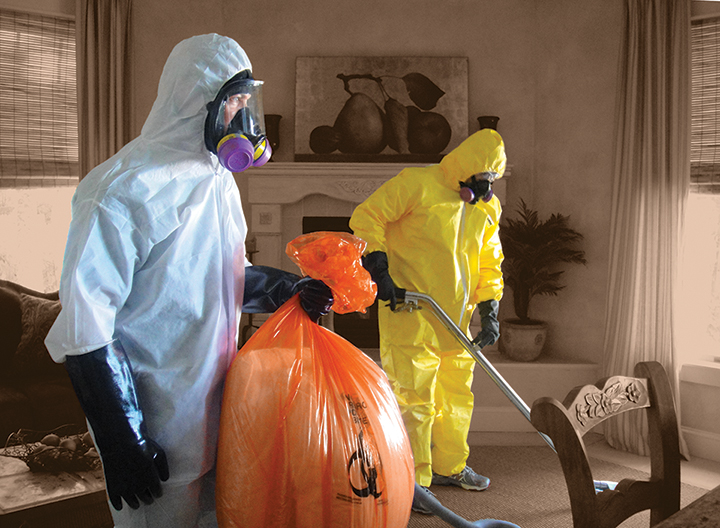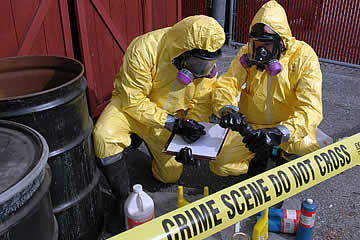Biohazard Removal: Safe Handling and Disposal of Hazardous Materials
Biohazard Removal: Safe Handling and Disposal of Hazardous Materials
Blog Article
Expert Biohazard Cleaning and Decontamination for Blood, Bodily Fluids, and Hazardous Materials
In the world of biohazard cleansing and purification for blood, bodily fluids, and hazardous products, accuracy and experience are paramount. The possible health and wellness dangers connected with direct exposure to biohazards emphasize the vital requirement for meticulous handling and comprehensive cleanup. Specialized training outfits experts with the knowledge and abilities needed to deal with these hazardous scenarios efficiently. However, it is not just regarding cleansing up; the value of utilizing proper purification methods can not be overemphasized. As we browse the elaborate landscape of biohazard cleaning, comprehending the subtleties of policies, conformity, and the specific tools at play ends up being important in ensuring a risk-free and comprehensive purification process.
Health Threats of Biohazard Exposure
Exposure to biohazards positions considerable wellness threats that can cause severe consequences for neighborhoods and individuals alike. Biohazards include a large range of biological compounds, including blood, physical liquids, mold and mildew, microorganisms, infections, and various other possibly transmittable products. When people come into call with these biohazards, whether with mishaps, incorrect handling, or environmental exposure, they face the risk of contracting serious diseases or diseases.
One of the key health and wellness risks linked with biohazard direct exposure is the transmission of contagious illness. Bloodborne pathogens such as HIV, hepatitis B and C, and various bacteria can be existing in biohazardous products, presenting a straight risk to human health. Inhaling air-borne biohazards like mold and mildew spores or entering into call with polluted surfaces can likewise cause breathing concerns, allergic reactions, and various other damaging health and wellness impacts.
Additionally, biohazard exposure can have lasting health and wellness implications, with some conditions showing up years after the first get in touch with (Blood Cleanup). Consequently, it is critical to prioritize proper biohazard cleansing and decontamination to mitigate these wellness dangers and ensure the security of communities and people

Specialized Educating for Biohazard Clean-up
When it concerns taking care of biohazard cleanup effectively and securely, specialized training plays a fundamental role in making sure proper decontamination procedures are complied with. Biohazard cleanup requires certain expertise and abilities to effectively reduce dangers linked with bloodborne pathogens, bodily fluids, and dangerous materials. Specialists educated in biohazard cleaning undergo rigorous instruction on exactly how to safely manage, get rid of, and dispose of biohazardous materials to prevent contamination and exposure.
Specialized training for biohazard clean-up covers a series of necessary subjects, consisting of correct individual safety tools (PPE) usage, bloodborne microorganism awareness, decontamination techniques, and dangerous waste disposal procedures. Individuals learnt biohazard cleanup are outfitted with the required know-how to evaluate contamination levels, identify potential threats, and apply ideal cleaning treatments in compliance with regulatory criteria.
Continual training and education and learning are paramount in the area of biohazard cleaning to remain updated on the current decontamination technologies, safety and security procedures, and policies. By investing in specialized training, biohazard cleaning specialists can efficiently reply to emergency situation cleanup situations and secure both public health and the setting.
Value of Appropriate Decontamination Strategies
Utilizing correct decontamination strategies is crucial in biohazard cleaning to successfully remove harmful materials and decrease health and wellness risks. Reliable decontamination not just makes blood cleanup certain the elimination of visible traces of blood, bodily liquids, and other biohazards yet also targets unseen pathogens that might pose significant health and wellness hazards otherwise properly eliminated. By adhering to strict purification protocols, trained specialists can considerably lower the risk of exposure to hazardous microorganisms, viruses, and microorganisms that could result in diseases or infections.
Proper purification strategies involve the use of specific devices and anti-bacterials that are especially developed to reduce the effects of biohazards properly. Extensive cleansing and sanitation of infected areas are important to stop the spread of virus and make sure a risk-free atmosphere for owners. In addition, the correct disposal of biohazardous waste following decontamination procedures is important in avoiding contamination of various other surface areas or people.

Tools and Devices for Safe Clean-up
When dealing with blood, bodily liquids, or hazardous materials, biohazard cleansing specialists rely on specialized equipment to decrease exposure dangers and thoroughly decontaminate the damaged area. Furthermore, biohazard cleansing packages consisting of anti-bacterials, absorbent products, and biohazard bags are used to safely dispose and consist of of infected items.
Advanced cleaning devices like hospital-grade anti-bacterials, HEPA-filtered vacuum cleaners, and fogging devices are utilized to sterilize surface areas and remove biohazards efficiently. Specialized tools such as sharps containers and biohazard garbage disposal containers are utilized to safely handle sharp items and biohazardous waste products. By using the right tools and tools, biohazard cleaning experts can make sure an extensive cleaning process that focuses on safety and security and minimizes health and wellness dangers for both employees and passengers of the afflicted space.
Laws and Compliance in Biohazard Cleansing
Proper adherence to policies and compliance standards is critical in biohazard cleaning to guarantee the security of both workers and the atmosphere. Government companies such as OSHA (Occupational Safety and Health Administration) and the EPA (Environmental Protection Agency) have actually developed certain standards for biohazard clean-up treatments to decrease wellness dangers and environmental contamination. These policies cover a variety of facets consisting of the handling, transport, and disposal of biohazardous materials, as well as the essential training and safety devices this content required for employees involved in the cleanup procedure.
Biohazard cleaning companies have to remain updated with these regulations to assure that their procedures meet the required safety and security requirements. Failure to abide by these policies can cause serious repercussions, including penalties, lawsuit, and threatening the health of people and the atmosphere. By following rigid policies and conformity procedures, biohazard cleaning business can effectively mitigate threats and guarantee a detailed and risk-free cleanup procedure for all events included.
Verdict
To conclude, biohazard cleansing and decontamination need customized training, correct methods, and adherence to regulations. Exposure to blood, physical fluids, and dangerous products poses substantial wellness risks, making it crucial to utilize the appropriate equipment and devices for secure cleanup. By complying with rigorous over here protocols and guidelines, experts can properly mitigate the threats connected with biohazard exposure and make certain the safety of both themselves and others.
As we navigate the elaborate landscape of biohazard clean-up, recognizing the subtleties of regulations, compliance, and the specific devices at play comes to be critical in making sure a secure and detailed decontamination process. (Blood Cleanup)
When it comes to managing biohazard clean-up effectively and securely, specialized training plays an essential duty in making certain correct purification treatments are adhered to.Making use of appropriate decontamination techniques is important in biohazard clean-up to efficiently minimize and eliminate hazardous products wellness threats. In addition, biohazard cleansing sets including disinfectants, absorbing products, and biohazard bags are utilized to safely get rid of and consist of of polluted items.
Federal government companies such as OSHA (Occupational Safety And Security and Health Management) and the EPA (Environmental Defense Company) have developed details guidelines for biohazard cleanup treatments to lessen health threats and ecological contamination.
Report this page